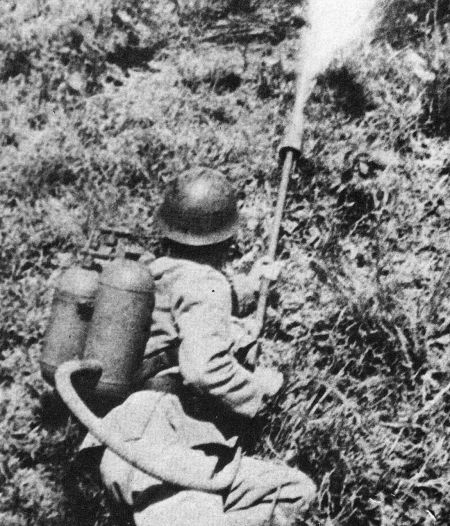Japanese Type 93 Flamethrower.
Type 100 Flamethrower.
The Japanese Model 93 and 100 portable flamethrowers were almost identical- this is the Model 93-and differed only in the shape of the name gun and other minor changes. Two tanks held the fuel and the other was the nitrogen pressure tank, providing a flame jet duration of 10 to 12 seconds.
If war-time propaganda photographs are to be believed, the Japanese army and marines made extensive use of flamethrowers during World War II. This impression came largely from a long series of ‘official’ photographs taken during Japan’s protracted war against the Chinese, where weapons such as flamethrowers could have a morale effect that far outweighed their usefulness as combat weapons. Against the flimsy structures used as housing throughout mainland China flame weapons could gain impressive results, and accordingly the Japanese made much use of them.
At first the main version used by the Japanese was the Portable Flamethrower Type 93. This was first issued during 1933 and was an orthodox design that made much use of German experience in World War I. It used three cylinders on a rather awkward back-pack arrangement, two of the cylinders containing the fuel and the central (and smaller) cylinder containing the compressed gas. When the Type 93 was first issued this was compressed nitrogen, but this was soon changed to compressed air. From 1939 onwards a small petrol-driven air compressor was issued with each equipment. This was the Type 99 compressor and when not in use it was transported in a small wooden case.
For various reasons the flame projector of the Type 93 was considered to be unsatisfactory, and in 1940 it was changed to a new type. This was known as the Portable Flamethrower Type 100, but in every other aspect it was identical to the Type 93. The new flame gun was shorter than the earlier model – 901 mm (35.5 in) as opposed to 1.197 m (47.125 in). The nozzle of the flame gun could also be easily changed on the Type 100, whereas on the Type 93 it was fixed.
Although the Japanese infantry made use of flamethrowers, the Japanese tank formations made only limited use of the weapon. Apparently only one attempt was made to produce flamethrower tanks and this was a small unit of specialized combat engineering tanks that were encountered on Luzon in 1944. These turretless tanks were fitted with obstacle-clearing equipment on the front hull and mounted a single flamethrower forward. Both internal and external fuel tanks were carried. The tank used as the basis appear to have been the Type 98 medium, whose only other armament was a single machine-gun.
Specification Portable Flamethrower Type 100 Weight: 25 kg (55 lb) Fuel capacity: 14.77 litres (3.25 Imp gal) Range: about 22.9 to 27.4 m (25 to 30 yards) Duration of fire: 10 to 12 seconds
